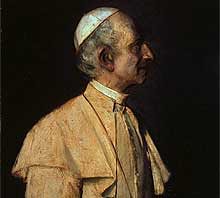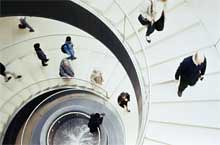I recently sent an email to a good friend about a Diocese whose bishop has banned kneeling to receive communion. He's also decided to ban kneeling during communion -- after communing, all parishioners are to stand and sing hymns. This is to be done, he says, because allowing private prayer after communion "privatizes" the Mass and contradicts its essential nature as a communal celebration. He also contends that the GIRM (both in its 1974 version and as recently amended) requires standing during communion. The Diocese's newspaper has been running editorials and carefully-selected letters to the editor castigating Catholics who kneel to receive communion as manifesting "open dissent from the mind of the Church," of disobeying a direct command from the Vatican, and who are therefore rejecting unity in obedience to a successor of the Apostles, i.e. rejecting Catholicism itself.
My email set out some of my thoughts on the matter, and was also sent to the redoubtable I. Shawn McElhinney who brilliantly blogs at Rerum Novarum. Shawn has great insights into, and deep knowledge of, the peculiarities of Catholicism's manner of self-government. Don't let my hearty and confident (or bombastic and pompous, take your pick) tone in this post and others fool you. This issue is really tearing at me and, I suspect, others who could use the benefit of Shawn's counsel. By stating my arguments as forcefully as I can, and with as much sang froid as I can, I hope to gain not only an education but avoid tedious public displays of my own hand-wringing on the matter. Fortunately, Shawn and some of my other correspondents are marshaling replies by blog and email. I will offer my responses presently, but for the record here's the original email (sent to a friend) in all its gory details:
Bishop X is wrong when he says the GIRM requires standing during communion, and wrong when he says that to the Diocese in the Diocesan Paper. In view of ¶ 43 of the 2000 US-GIRM, I don't understand how that mistake could be made. Even the 1974 US-GIRM was interpreted by the Vatican to make standing during communion optional: "Thus it [standing] is a matter of option, not obligation." Notitiae 10 (1974) 407. Bishop Bruskewitz posed our question about the new GIRM adaptations to the Congregation for Divine Worship and the Discipline of the Sacraments:
Query: Is it the case that the Congregation for Divine Worship and the Discipline of the Sacraments, by no. 43 of the Institutio Generalis Missalis Romani, [the new 2000 GIRM] intends to prohibit the faithful from kneeling after the Agnus Dei and following reception of Communion?
Response: Negative.
-- Congregation for Divine Worship and the Discipline of the Sacraments, Prot. 2372/00/L, 7 November 2000.
No one can truly say that the GIRM requires, or that it is even intended to require, the faithful to stand during communion. What the GIRM intends to do, at best, is to consign standing during communion to the personal preference of the Bishop. That makes the relevance of "obedience" very hazy and uncertain, since Catholics aren't under a moral obligation to conform themselves to the personal preferences of their Bishop. We don't have to drive the same car he does, like the same television shows he does, etc. Certainly posture during Holy Communion is a much more serious matter, but that only means the USCCB's amendments aren't treating the subject as seriously as it deserves, and who owes obedience in that context? Appeals to the Bishop's authority as "chief liturgist" is self-referential silliness, in my view, since "liturgists" are simply administrative functionaries whose purpose is to facilitate the observation of the rite per the GIRM. In light of ¶ 43 of the US-GIRM, saying the Bishop is "chief liturgist" is merely saying he's chiefly responsible for determining his personal preference about posture for communion.
I'm not sure I can agree with your statement that kneeling to receive communion is "illicit." Recall that the Congregation for Divine Worship and the Discipline of the Sacraments ("CDWDS") is the body with final authority over the GIRM and its US adaptations. Even in light of ¶ 43 of the US-GIRM, Bishop X's authority to prefer one posture over another is subject to the CDWDS' ruling. The CDWDS has vigorously condemned the practice (which has occurred in this Diocese) of refusing communion to kneeling Catholics. In its condemnation, the Congregation said:
In fact, as His Eminence, Cardinal Joseph Ratzinger has recently emphasized, the practice of kneeling for Holy Communion has in its favor a centuries-old tradition, and it is a particularly expressive sign of adoration, completely appropriate in light of the true, real and substantial presence of Our Lord Jesus Christ under the consecrated species.
-- Congregation for Divine Worship and Discipline of the Sacraments, Protocol # 1322/02/L, 1 July 2002. The text may be found at http://www.adoremus.org/Notitiae-kneeling.html .
How can kneeling be "completely appropriate" and "illicit"? Given the fact that Bishop X's actions under ¶ 43 (as well as the USCCB's actions under ¶ 160) are nothing more than the exercise of personal or local preferences under an authority which itself expressly requires bishops to recognize kneeling as "completely appropriate," I think the word "illicit" is well-nigh calumny, although I know you don't intend it that way.
I also think that ¶ 160 doesn't lay down any rule at all. It says that the "norm" for the reception of communion is standing. What is a "norm"? It is a thing which may be frequent, or required, or both. It is the "norm" for drivers in the United States to exceed the speed limit, but it is not the "norm" that they be required to do so. It is the "norm" for Catholics to avoid contraception, but as all the polls tell us, eschewing contraception is not the "norm" among American Catholics. Is the word a perception, or a command? As the CDWDS has already said, it is not a command. Therefore it is a perception. I don't have to obey the Bishops' perceptions of what Catholics do at Mass any more than I have to obey their perceptions of where Catholics eat breakfast after Mass. In contrast, any custom of more than thirty years' duration among the faithful capable of receiving a law, which is approved by a competent legislator can then have the force of law. Codex Iuris Canonici, Can. 23-27. Catholics were kneeling at Mass before 1973, and the CDWDS has approved the custom as "completely appropriate" for the celebration of Mass. I'm not a canon lawyer by any means, nor a "liturgist," but I am a betting man and I'd wager on kneeling being a custom with the force of law before I put money on ¶ 160's "norm" really meaning "a command binding on pain of (even venial) sin."
I must say I've been astounded by the Diocesan Paper's public campaign encouraging Catholics in this Diocese to regard their kneeling brothers and sisters as schismatics, heretics, and betrayers of the faith. Calumny, detraction, and suspicion are not things one expects to find in a Diocesan newspaper. The Diocesan Paper has in fact claimed that kneeling Catholics are disobeying the direct instructions of the Vatican. That is calumnious. The Diocesan Paper has in fact claimed that kneeling Catholics are disregarding the personal preference of the Bishop, and doing so in a climate (which its own pages have intentionally created) where that can only bring obloquy and odium to them. That is detracting. The Diocesan Paper has in fact claimed that Catholics kneel because we have unworthy motives of rebellion and antipathy for Catholicism. That is suspicion. I'm sure this scandalous cruelty stems (like all cruelty) from what are thought to be the highest and purest motives, and that the editors would be upset to think they're intentionally driving Catholics out of their parishes in tears (which has, in fact, happened) and provoking animosity and spitefulness between Catholics and their priests (which has, in fact, occurred). But that doesn't make it right, or even sane.
If a campaign to encourage perceptions of schism, heresy, and betrayal is warranted, then surely it is warranted regarding a host of subjects about which the Diocsean Paper has remained oddly and timidly silent. There are Catholic politicians in this Diocese who support abortion on demand and receive communion regularly. There are Catholics in this Diocese who regularly commune despite having divorced and remarried without recourse to the Church's annulment tribunal. There are Catholics in this Diocese who use contraception and provide it to their children, and there are Catholics in this Diocese who openly condone homosexuality. As far as one can tell from the Diocesan Paper's silence, a Catholic who does these things need not fear for his reputation, because he uses a politically-correct posture to "eateth and drinketh damnation to himself, not discerning the Lord's body." (1 Cor. 11:29). I am put in mind of what Julia told Winston in 1984 -- so long as you keep the little rules, you can break all the big ones. That seems to be the Diocesan Paper's editorial priority as well -- who cares if you put your fourteen-year-old daugher on the pill, so long as you keep her from kneeling to receive communion! And isn't it doubly-odd to imagine a fourteen-year-old girl who kneels to receive communion being on the pill to avoid getting pregnant by her fifteen-year-old boyfriends? If you ask me, there's a question far more worthy of the Diocesan Paper's resources than its present affection for twine-and-chewing-gum arguments about the heresy of people who want to immitate St. Padre Pio and kneel whenever God appears.











No comments:
Post a Comment